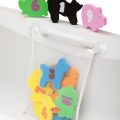Why a month-old baby cries
Crying is a newborn's way of communicating with the world and with you. A month-old baby cries when he feels hungry or uncomfortable. Photo: Getty The reasons for crying are:
A month-old baby cries when he feels hungry or uncomfortable. Photo: Getty The reasons for crying are:
- Hunger. Touch the corner of the baby's mouth with your finger. If he opens his mouth and tries to catch him with his lips, then he wants to eat. Crying, as a rule, is intermittent.
- Colic. With intestinal colic, the newborn strains the legs and squeezes the jaws, pulls them, tears out from the scream. Often the face turns red during the scream.
- Pain. Symptoms are similar, as with intestinal colic, but last more than 3 hours.
- Temperature. Touch the baby's wrists, as well as the neck. These places react quickly to rising and falling temperatures. When the baby is cold, he cries silently and intermittently. If he is hot, he makes a loud scream. The little face turns red at the same time.
- Fatigue. The baby whimpers, offensively screams and fits when tired and can not sleep on his own. Often these symptoms are observed in the evening.
- Diaper. The unpleasant sensations caused by the overcrowded diaper cause a mournful silent crying.
- Fear. If the child is alone for a long time, he starts screaming. Loneliness causes fear in the child.
These are the main reasons that cause crying in a newborn.
What to do if a month old baby cries
Don't ignore your baby's crying.Eliminate all possible causes one by one. Feed your baby when he wants, not on a schedule. Change his diaper regularly. Use a sling so that your baby spends more time with you. If your baby wants to sleep, he needs his mother's breast, parental hugs, and gentle rocking to calm him down. Offer your baby a pacifier. If your baby does not fall asleep alone in his crib, put a lactation disk soaked in mother's milk. This will give your baby a sense of calm that his mother is nearby. If your baby has colic, consult your pediatrician. The following remedies usually help:
- Special drops, dill water, tea with fennel. Give them with a spoon, using a bottle or a syringe without a needle.
- Gas outlet tube. To insert it, use vegetable oil.
- Light massage. When massaging the abdomen, move the palm clockwise.
- Vertical position. After feeding, hold the child in his arms vertically, until it spews up the air entrained with food.
- Warm sheets. Put her baby on her tummy.
- Horizontal position. Before feeding, put your baby's belly on his lap to facilitate the escape of gases.
Use several methods at once.This will help the newborn get rid of pain faster. Don't worry if your one-month-old baby cries constantly. Very soon you will learn to understand the reason for his anxiety and quickly eliminate it. Also interesting:









